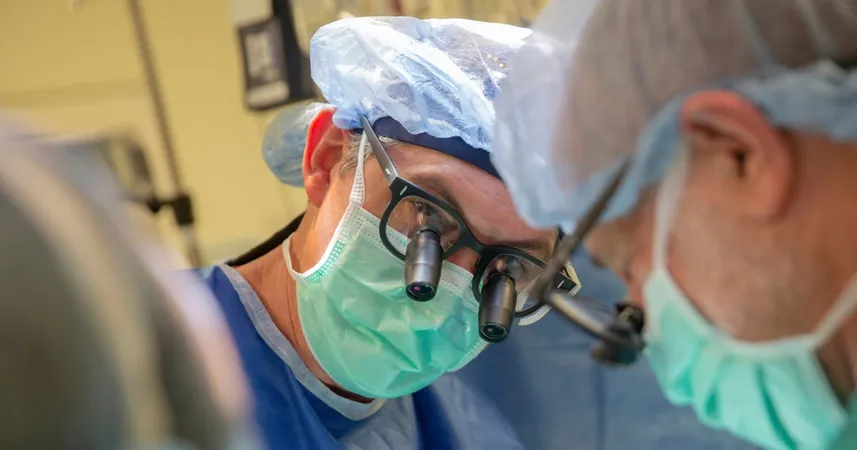
Revolutionary Breakthroughs in Heart Transplant Technology Could Save Lives!
2025-07-17
Author: Daniel
In a groundbreaking move, two prestigious university hospitals are redefining the heart transplant landscape for both adults and infants, aiming to boost the number of viable heart donations that often go to waste.
Known as Donation After Circulatory Death (DCD), the controversial method has faced criticism due to the complexity of its recovery techniques and the use of sophisticated equipment. However, surgeons from Duke and Vanderbilt University have independently unveiled simpler, more effective methods for heart retrieval that promise to make a significant impact.
New Techniques Show Promise in Heart Transplants
In a recent issue of the New England Journal of Medicine, the teams reported successful transplants: one heart was given to a 3-month-old infant at Duke, while Vanderbilt facilitated transplants for three men. According to Dr. Aaron M. Williams, the lead researcher at Vanderbilt, "These DCD hearts work just as well as hearts from brain-dead donors," a statement that could change the future of organ donation.
Understanding the DCD Process
Traditionally, most transplanted hearts come from brain-dead donors kept on ventilators until organ retrieval. In contrast, DCD occurs when a patient with an irreversible brain injury has life support withdrawn, leading to the heart's cessation. This timeline can lead to questions about the quality of hearts that have spent time without oxygen.
To address this issue, surgeons have been experimenting with techniques such as normothermic regional perfusion (NRP), which artificially restores circulation. However, many hospitals ban this ethically controversial method.
Innovative Solutions in Heart Recovery
Duke’s Dr. Joseph Turek and his team have found a workaround—by removing the heart and connecting it to tubes that supply oxygen and blood for a brief assessment right in the operating room. In a recent test, after a 1-month-old donor was brought in, Turek's team quickly evaluated the heart’s functionality in just five minutes, confirming it was suitable for transport.
Vanderbilt, on the other hand, employs a different yet straightforward method. The heart is infused with a nutrient-rich solution, preserving its condition before removal, eliminating the need for the intricate reanimation process. Dr. Williams has noted that this technique has so far enabled about 25 successful transplants.
Urgent Need for More Donated Hearts
The demand for transplantable hearts is staggering. With hundreds of thousands of adults suffering from severe heart failure and roughly 700 children waiting for transplants annually—20% of whom tragically die while on the waiting list—these innovations are crucial.
Last year, individuals who succumbed to circulatory death accounted for 43% of deceased donors, but only 793 of the 4,572 heart transplants performed. This stark contrast underscores the importance of discovering new methods to utilize these potential heart donations.
A Bright Future for Heart Transplantation?
Experts believe that these emerging research studies, although early-stage, signal a hopeful future for expanding viable heart options. Brendan Parent from NYU Langone Health asserts, "Innovation to effectively recover organs post-circulatory death is absolutely essential to alleviate the organ shortage." If these alternatives prove successful, hospitals may embrace them wholeheartedly, especially those hesitant to adopt current methods.

 Brasil (PT)
Brasil (PT)
 Canada (EN)
Canada (EN)
 Chile (ES)
Chile (ES)
 Česko (CS)
Česko (CS)
 대한민국 (KO)
대한민국 (KO)
 España (ES)
España (ES)
 France (FR)
France (FR)
 Hong Kong (EN)
Hong Kong (EN)
 Italia (IT)
Italia (IT)
 日本 (JA)
日本 (JA)
 Magyarország (HU)
Magyarország (HU)
 Norge (NO)
Norge (NO)
 Polska (PL)
Polska (PL)
 Schweiz (DE)
Schweiz (DE)
 Singapore (EN)
Singapore (EN)
 Sverige (SV)
Sverige (SV)
 Suomi (FI)
Suomi (FI)
 Türkiye (TR)
Türkiye (TR)
 الإمارات العربية المتحدة (AR)
الإمارات العربية المتحدة (AR)